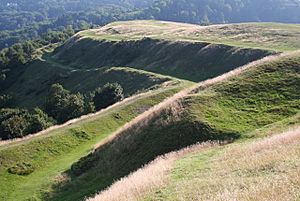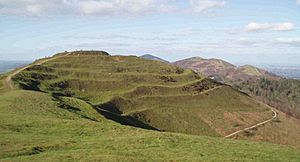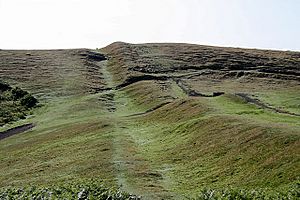British Camp facts for kids
British Camp is an ancient Iron Age hill fort located at the top of Herefordshire Beacon in the Malvern Hills. This amazing old fort is a protected historical site, looked after by the Malvern Hills Conservators. People think it was first built around 200 BC. Later, a Norman castle was even built right on top of it! Today, you can still clearly see the huge earthworks – these are big banks and ditches made of earth – that give the hill its unique shape. The top of British Camp is about 1,109 feet (338 m) high.
Contents
What is British Camp?
British Camp is made up of huge earthworks that some people say look like a giant wedding cake! Another hill fort called Midsummer Hill is only about a mile south of British Camp. Inside British Camp, you can find many round, flat areas. These might be where ancient huts once stood, suggesting people lived there all the time. It's quite unusual to have two big hill forts so close to each other.
A famous writer named John Evelyn (who lived from 1620 to 1706) once said that the view from British Camp was "one of the godliest vistas in England." This means he thought it was one of the most beautiful views in the whole country!
Exploring the Fort's Defenses
The defenses of British Camp include a ditch and a bank that go all the way around the site. These defenses cover three hills, though the hills to the north and south are quite small. The entire perimeter of the defenses is about 6,800 feet (2,100 m) long, protecting an area of around 44 acres (18 ha).
The very first earthworks were built around the base of the central hill, which is sometimes called the "citadel." Experts have found at least four different building stages from prehistoric times. It seems there were original gates on the east, west, and northeast sides of the fort.
British Camp and the Romans
We don't know for sure if the arrival of the Romans stopped people from using British Camp. However, there's a popular story that the ancient British leader Caratacus fought his last battle against the Romans right here.
But this story is probably not true. A Roman historian named Tacitus described Caratacus's last battle as being closer to the River Severn. Other nearby hill forts, like Midsummer Hill, Bredon Hill, and Croft Ambrey, show signs of being violently destroyed around 48 AD. This might mean that British Camp was also abandoned or destroyed around the same time.
The Medieval Castle at British Camp
Sometimes, medieval castles were built inside older sites, like Iron Age hill forts. This happened at British Camp! A type of castle called a "ringwork and bailey" castle was built inside the Iron Age fort. It was also known as Colwall Castle or The Herefordshire Beacon. It was probably built just before 1066.
It's possible that Harold Godwinson, who later became King Harold II of England, built this castle. He is known to have built another fortress nearby. The castle at British Camp seems to have been made stronger during a time of civil war in England called The Anarchy, when King Stephen was on the throne.
Before 1148, the castle was held by Waleran de Beaumont, 1st Earl of Worcester. It changed hands again in 1151 and 1153 when royal armies attacked it. At that time, it was defended by the men of Earl Waleran's brother, Robert de Beaumont, 2nd Earl of Leicester. The castle was finally destroyed by King Henry II in 1155.
The Shire Ditch
The Shire Ditch, also called Red Earl's Dyke, runs north and south of British Camp along the top of the hills. It was dug in 1287 by Gilbert de Clare, the Earl of Gloucester. He built it after a disagreement about land boundaries with Thomas de Cantilupe, the Bishop of Hereford.
However, newer research suggests that the Shire Ditch might be much older than that! There's some evidence that it might have started as a prehistoric pathway. This path could have run from Midsummer Hill fort all the way to the Worcestershire Beacon, which is the highest hill in the Malvern range, over three miles north of British Camp.
Folklore and Legends
A popular legend says that Caratacus, a famous British tribal leader, fought his last battle against the Romans at British Camp. The story even says that after he was captured, he was taken to Rome. There, Emperor Claudius supposedly gave him a villa and a pension!
However, the description from Tacitus, the Roman historian, makes this story unlikely:
Caratacus chose a battleground where everything would be difficult for us and better for his own men. There were steep mountains all around, and where it was possible to approach, he placed rocks like a wall. A stream with a tricky crossing flowed in front, and armed soldiers were positioned along the defenses.
Even though you can see the River Severn from British Camp, it's about 8 kilometres (5 miles) away. This means the battle must have happened somewhere else. People have suggested other places, like sites near Brampton Bryan (an important Roman area) or Church Stretton, which also has an Iron Age fort on Caer Caradoc Hill.
Images for kids






